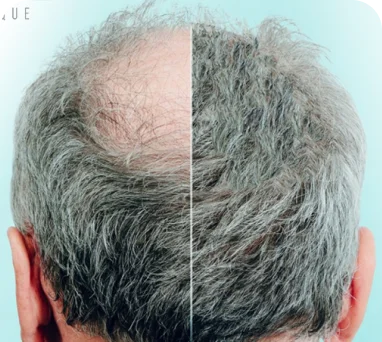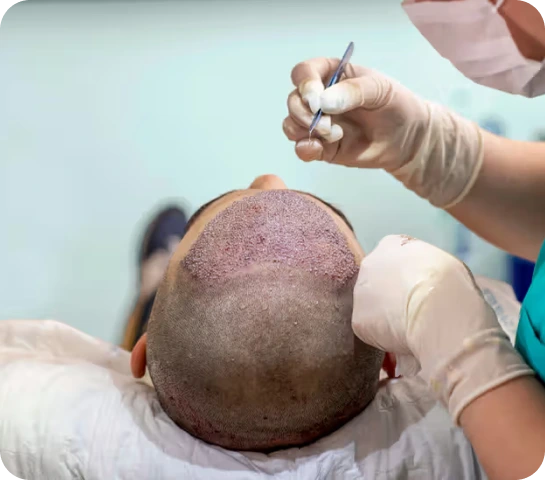Hair loss is a common condition that affects millions of people worldwide. It can be caused by a variety of factors, including genetics, hormonal changes, medical conditions, and lifestyle choices. Hair growth, on the other hand, is a natural process that occurs in cycles. Understanding the causes of hair loss and the science behind hair growth is crucial in finding effective solutions for revitalizing hair.
There are several common causes of hair loss. One of the most common is male pattern baldness, which is caused by a combination of genetics and hormonal changes. Other causes include stress, nutritional deficiencies, certain medications, and medical conditions such as alopecia areata. Understanding the underlying cause of hair loss is important in determining the most appropriate treatment method.

Revitalizing Hair with Graft Transplants
Key Takeaways
- Hair loss is a common problem that affects both men and women.
- Graft transplants can help revitalize hair by transplanting healthy hair follicles to areas of thinning or balding.
- PlasmaMedica and PRP use the body’s own growth factors to stimulate hair growth and improve the success of graft transplants.
- Using PlasmaMedica and PRP for hair growth can lead to thicker, fuller hair and improved self-confidence.
- The procedure for graft transplants with PlasmaMedica and PRP involves a minimally invasive process with little downtime and minimal discomfort.
The Role of Graft Transplants in Revitalizing Hair
Graft transplants are a popular method for revitalizing hair and treating hair loss. This procedure involves taking hair follicles from one area of the body, typically the back or sides of the head, and transplanting them to areas where hair is thinning or balding. The transplanted hair follicles continue to grow naturally, resulting in fuller and thicker hair.
Graft transplants can help with hair loss by providing a permanent solution to thinning or balding areas. Unlike other temporary solutions such as wigs or medications, graft transplants offer long-lasting results. The transplanted hair follicles are resistant to the hormone DHT, which is responsible for causing hair loss in individuals with male pattern baldness.
The Science Behind PlasmaMedica and PRP
PlasmaMedica and Platelet-Rich Plasma (PRP) are innovative treatments that have shown promising results in promoting hair growth. PlasmaMedica is a medical device that uses plasma technology to stimulate hair follicles and promote new hair growth. PRP, on the other hand, is a treatment that involves injecting a concentrated solution of platelets into the scalp to stimulate hair growth.
PlasmaMedica works by delivering a controlled amount of plasma energy to the scalp. This energy stimulates the hair follicles, promoting increased blood flow and nutrient delivery to the hair follicles. This, in turn, promotes the growth of new hair and revitalizes existing hair.
PRP works by harnessing the healing properties of platelets. Platelets contain growth factors that promote tissue repair and regeneration. When injected into the scalp, PRP stimulates the hair follicles and promotes new hair growth. It also improves the overall health of the scalp, resulting in thicker and healthier hair.
How PlasmaMedica and PRP Can Help with Hair Loss
| Metrics | Explanation |
|---|---|
| Platelet-Rich Plasma (PRP) | A treatment that uses a patient’s own blood to promote hair growth by injecting concentrated platelets into the scalp. |
| PlasmaMedica | A medical company that specializes in developing and providing PRP treatments for hair loss. |
| Hair Density | The number of hair follicles per square centimeter of scalp. PRP treatments can increase hair density by stimulating hair growth. |
| Hair Thickness | The diameter of individual hair strands. PRP treatments can improve hair thickness by strengthening hair follicles. |
| Hair Growth Cycle | The three stages of hair growth: anagen (growth), catagen (transition), and telogen (resting). PRP treatments can prolong the anagen phase, leading to longer and thicker hair. |
| Side Effects | Minimal side effects, such as mild pain or swelling at the injection site, may occur after PRP treatments. |
| Candidate Eligibility | PRP treatments are suitable for individuals with androgenetic alopecia (male or female pattern baldness) and other types of hair loss. |
PlasmaMedica and PRP offer several benefits for individuals experiencing hair loss. Firstly, they are non-surgical treatments, which means they do not require any incisions or stitches. This makes them a safe and minimally invasive option for individuals who are not suitable candidates for surgery.
Secondly, PlasmaMedica and PRP can be used to treat various types of hair loss. Whether it is male pattern baldness, female pattern baldness, or alopecia areata, these treatments have shown promising results in promoting hair growth and revitalizing thinning or balding areas.
Additionally, PlasmaMedica and PRP treatments are natural and safe. They utilize the body’s own healing mechanisms to stimulate hair growth, making them a preferred choice for individuals who prefer natural solutions over medications or surgical procedures.
The Benefits of Using PlasmaMedica and PRP for Hair Growth
There are several benefits to using PlasmaMedica and PRP for hair growth. Firstly, these treatments are effective in promoting new hair growth and revitalizing existing hair. Many individuals have reported significant improvements in hair density and thickness after undergoing PlasmaMedica and PRP treatments.
Secondly, PlasmaMedica and PRP treatments are safe and have minimal side effects. Since they utilize the body’s own healing mechanisms, there is a reduced risk of adverse reactions or complications. This makes them suitable for individuals with sensitive skin or those who are concerned about the potential side effects of medications or surgical procedures.
Furthermore, PlasmaMedica and PRP treatments are convenient and require minimal downtime. Unlike surgical procedures that may require weeks or months of recovery, these treatments allow individuals to resume their normal activities immediately after the procedure. This makes them a popular choice for individuals with busy lifestyles.
The Procedure for Graft Transplants with PlasmaMedica and PRP

The procedure for graft transplants with PlasmaMedica and PRP involves several steps. Firstly, the patient’s scalp is numbed using a local anesthetic to ensure a comfortable experience. Then, hair follicles are extracted from the donor area using a specialized tool. These hair follicles are carefully prepared and sorted before being transplanted into the recipient area.
During the transplantation process, PlasmaMedica is used to stimulate the hair follicles and promote new hair growth. The plasma energy is delivered to the scalp using a handheld device, which ensures precise and controlled delivery of energy to the hair follicles.
Preparing for Graft Transplants with PlasmaMedica and PRP
Before undergoing graft transplants with PlasmaMedica and PRP, it is important to follow certain guidelines to ensure optimal results. Firstly, it is recommended to avoid smoking and alcohol consumption for at least one week before the procedure, as these can interfere with the healing process.
Secondly, it is important to inform the healthcare provider about any medications or supplements being taken, as some may need to be temporarily discontinued before the procedure. Additionally, it is important to follow any pre-procedure instructions provided by the healthcare provider, such as avoiding certain foods or beverages.
Post-Procedure Care for Graft Transplants with PlasmaMedica and PRP
After undergoing graft transplants with PlasmaMedica and PRP, it is important to follow proper post-procedure care to ensure optimal results. Firstly, it is important to avoid touching or scratching the scalp for at least 48 hours after the procedure, as this can disrupt the healing process.
Secondly, it is important to avoid strenuous activities or exercise for at least one week after the procedure, as this can increase the risk of complications. Additionally, it is important to follow any post-procedure instructions provided by the healthcare provider, such as using specific hair care products or avoiding certain hair treatments.
Results and Success Stories of Graft Transplants with PlasmaMedica and PRP
There have been numerous success stories of individuals who have undergone graft transplants with PlasmaMedica and PRP. Many individuals have reported significant improvements in hair density and thickness, as well as increased confidence and self-esteem.
Before and after photos of individuals who have undergone graft transplants with PlasmaMedica and PRP show remarkable transformations. Thinning or balding areas are replaced with thick and healthy hair, resulting in a more youthful appearance.
Achieving Revitalized Hair with Graft Transplants and PlasmaMedica
In conclusion, graft transplants with PlasmaMedica and PRP offer a safe and effective solution for individuals experiencing hair loss. These treatments promote new hair growth and revitalize thinning or balding areas, resulting in thicker and healthier hair.
The benefits of using PlasmaMedica and PRP for hair growth are numerous. They are non-surgical, safe, and convenient, making them suitable for individuals with various types of hair loss. Additionally, they offer long-lasting results and have minimal downtime.
If you are experiencing hair loss and are looking for a natural and effective solution, consider graft transplants with PlasmaMedica and PRP. Consult with a healthcare provider to determine if these treatments are suitable for you and to learn more about the procedure and expected results. With the advancements in medical technology, achieving revitalized hair is now within reach.
FAQs
What is graft in hair transplant?
Graft in hair transplant refers to the process of removing hair follicles from one part of the body (usually the back of the head) and transplanting them to the bald or thinning areas of the scalp.
How is grafting done in hair transplant?
Grafting in hair transplant is done using two main techniques: Follicular Unit Transplantation (FUT) and Follicular Unit Extraction (FUE). FUT involves removing a strip of skin from the donor area and dissecting it into individual follicular units, while FUE involves extracting individual follicular units directly from the donor area using a small punch tool.
What is the success rate of grafting in hair transplant?
The success rate of grafting in hair transplant depends on various factors such as the skill and experience of the surgeon, the quality of the donor hair, and the patient’s overall health. However, on average, the success rate of hair transplant grafting is around 90%.
Is grafting in hair transplant a painful procedure?
Grafting in hair transplant is usually done under local anesthesia, which means that the patient does not feel any pain during the procedure. However, some patients may experience mild discomfort or soreness in the donor and recipient areas after the procedure, which can be managed with pain medication.
How long does it take for the grafts to grow after hair transplant?
It usually takes around 3-6 months for the transplanted grafts to start growing new hair. However, it may take up to 12-18 months for the full results of the hair transplant to be visible, as the hair grows gradually and naturally.
Are there any risks or complications associated with grafting in hair transplant?
Like any surgical procedure, grafting in hair transplant carries some risks and potential complications such as bleeding, infection, scarring, and poor graft survival. However, these risks can be minimized by choosing a qualified and experienced surgeon and following proper aftercare instructions.
